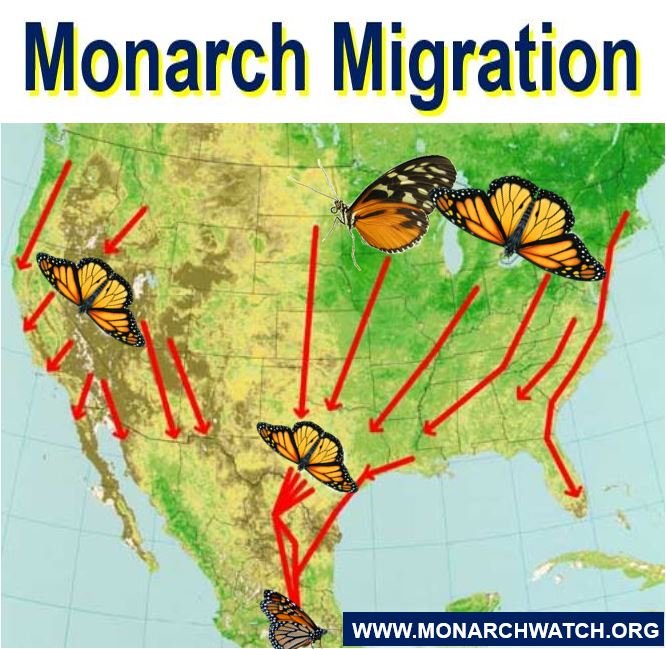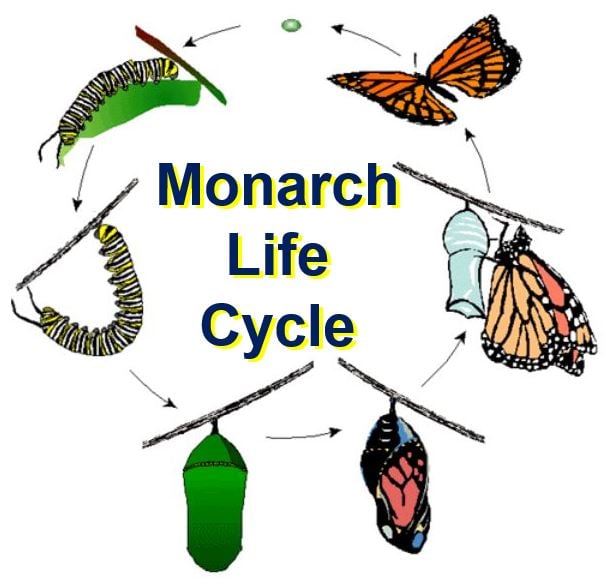Why does the monarch butterfly never get lost during its 2000 mile long migration? It has an internal, genetically encoded compass that allows it to find its way from the USA and Canada to the Central Mexico. Its compass integrates the sun’s position on the horizon and the time of day so that it can find the southerly direction, a team of researchers found.
Scientists have long wondered how the monarch butterfly (Danaus plexippus) knows exactly where to go each fall when it flies south.
Now, researchers from the University of Washington, the University of Massachusetts, and the University of Michigan wrote in the scientific journal Cell Reports (citation below) that they believe they have cracked the secret of this amazing insect’s compass.
 The scientists modeled how the monarch butterfly’s brain integrates the time of day with the sun’s position in the sky. (Image: washington.edu. Credit: Eli Shlizerman)
The scientists modeled how the monarch butterfly’s brain integrates the time of day with the sun’s position in the sky. (Image: washington.edu. Credit: Eli Shlizerman)
Compass integrates two pieces of data
Eli Shlizerman, a University of Washington assistant professor, explained:
“Their compass integrates two pieces of information – the time of day and the sun’s position on the horizon – to find the southerly direction.”
Researchers have known about the nature of the monarch butterfly’s ability to integrate the sun’s location in the sky and time of day from previous studies. However, nobody has ever understood how this butterfly’s brain receives and processes the data – that is, until now.
Prof. Shlizerman, and colleagues got together to model how the monarch’s compass is organized within its brain.
Prof. Shlizerman, lead author in this latest paper, said:
“We wanted to understand how the monarch is processing these different types of information to yield this constant behavior – flying southwest each fall.”
 3-D visualization of the Monarch butterfly’s brain with neuropils related to sun compass integration highlighted. (Image: cell.com)
3-D visualization of the Monarch butterfly’s brain with neuropils related to sun compass integration highlighted. (Image: cell.com)
Butterfly processes data on Sun’s position plus time of day
The monarch uses its large, complex eyes to track the Sun’s position in the sky. However, it cannot determine direction by the Sun’s position alone.
It also needs to combine that data with the time of day to know exactly where to go. Fortunately, like most animals, including us, monarchs have an internal clock based on the rhythmic expression of key genes.
This clock maintains a daily pattern of behaviour and physiology. The monarch’s clock is centrered in its antennae, and its information travels via neurons to the brain.
Scientists have previously studied the rhythmic pattern in the antennae of monarchs that control the internal clock, as well as how their compound eyes decipher the position of the Sun in the sky.
Prof. Shlizerman, Steven Reppert, Chair of the Department of Neurobiology at the University of Massachusetts Medical School, and colleagues recorded signals from monarchs’ antennae nerves as they transmitted clock information to the brain, and also light data from their eyes.
 According to National Geographic: “Every fall, as cold weather approaches, millions of these delicate insects leave their home range in Canada and the United States and begin flying south. They continue until they reach Southern California or central Mexico, more than 2,000 miles (3,200 kilometers) away!” (Image: monarchwatch.org)
According to National Geographic: “Every fall, as cold weather approaches, millions of these delicate insects leave their home range in Canada and the United States and begin flying south. They continue until they reach Southern California or central Mexico, more than 2,000 miles (3,200 kilometers) away!” (Image: monarchwatch.org)
How do eyes and antennae send data to the brain?
Prof. Shlizerman said:
“We created a model that incorporated this information – how the antennae and eyes send this information to the brain.”
“Our goal was to model what type of control mechanism would be at work within the brain, and then asked whether our model could guarantee sustained navigation in the southwest direction.”
In the researchers’ model, two neural mechanisms – one excitatory and one inhibitory – controlled signals from the antennae’s clock genes.
Their model had a similar system in place to detect the Sun’s position based on signals from the eyes. The balance between these control mechanisms would help the butterfly’s brain decipher which direction was southwest.
 According to Arizona State University: “There are four stages in the life cycle of a butterfly. The stages include, egg, larva, pupa, and adult. The entire process is called complete metamorphosis.” (Image: askabiologist.asu.edu)
According to Arizona State University: “There are four stages in the life cycle of a butterfly. The stages include, egg, larva, pupa, and adult. The entire process is called complete metamorphosis.” (Image: askabiologist.asu.edu)
Monarch never crosses ‘separation point’
Based on their model, it also appears that during course corrections the butterflies do not simply make the shortest turn to get back onto the right route. Their model includes a unique feature – a separation point that would control which way the monarch turned (left or right) to head in the southwest direction.
Prof. Shlizerman said:
“The location of this point in the monarch butterfly’s visual field changes throughout the day. And our model predicts that the monarch will not cross this point when it makes a course correction to head back southwest.”
According to their simulations, if a monarch butterfly is blown off course or an object in its path forces it to deviate, it will turn whichever way will not require it to cross the separation point.
The authors said further studies are required to confirm whether their model is consistent with monarch butterfly behaviour, physiology and brain anatomy. So far, aspects of their model, including the separation point, appear consistent with observed behaviours.
Prof. Shlizerman said:
“In experiments with monarchs at different times of the day, you do see occasions where their turns in course corrections are unusually long, slow or meandering. These could be cases where they can’t do a shorter turn because it would require crossing the separation point.”
Their model offers a simple explanation why monarch butterflies have the ability to reverse course in the spring and make their way northeast back to Canada and the United States from Central Mexico.
The four neural mechanisms that transmit data about the Sun’s position and the clock would simply need to work the other way round, i.e. in reverse direction.
Prof. Shlizerman said:
“And when that happens, their compass points northeast instead of southwest. It’s a simple, robust system to explain how these butterflies – generation after generation – make this remarkable migration.”
In a Summary in the journal, the authors wrote:
“The model demonstrates an integration mechanism, which produces robust trajectories reaching the southwest regardless of the time of day and includes a configuration for remigration.”
“Comparison of model simulations with flight trajectories of butterflies in a flight simulator shows analogous behaviors and affirms the prediction that midday is the optimal time for migratory flight.”
You can find more information at the project’s blog.
Citation: “Neural Integration Underlying a Time-Compensated Sun Compass in the Migratory Monarch Butterfly,” Eli Shlizerman, James Phillips-Portillo, Daniel B. Forger and Steven M. Reppert. Cell Reports. 14 April 2016. DOI: http://dx.doi.org/10.1016/j.celrep.2016.03.057.
Video – Time-compensated compass in Monarch Butterfly: Midday
Video – Time-compensated compass in Monarch Butterfly: Evening
